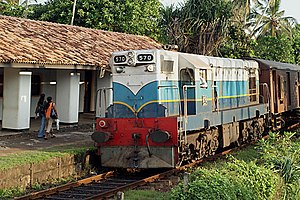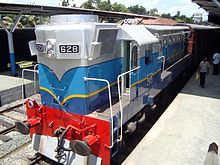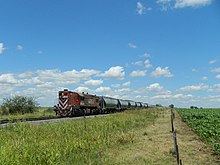
The Kowloon–Canton Railway was a railway network in Hong Kong. It was owned and operated by the Kowloon–Canton Railway Corporation (KCRC) until 2007. Rapid transit services, a light rail system, feeder bus routes within Hong Kong, and intercity passenger and freight train services to China on the KCR network, have been operated by the MTR Corporation since 2007.

Estrada de Ferro Santos-Jundiaí was a 1,600 mm gauge railway line in São Paulo, Brazil.

The Little Joe is a type of railroad electric locomotive built by General Electric. The locomotives had twelve axles, eight of them powered, in a 2-D+D-2 arrangement. They were originally intended to be exported to the Soviet Union and designed to operate on Soviet Railways (SZhD) 3,300-volt DC overhead line system. They were never exported to the Soviet Union due to rising political tensions. Only 20 were built, with 15 sold to domestic operators and five exported to Brazil.
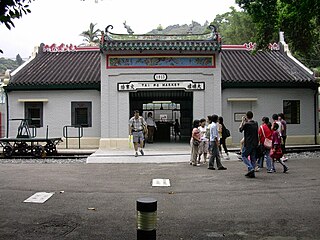
The Hong Kong Railway Museum is a railway museum in Tai Po, Hong Kong. It is now under the management of the Leisure and Cultural Service Department. Opened on 20 December 1985, it is located at the site where the old Tai Po Market railway station was built in 1913. Admission to the museum is free.

The Córas Iompair Éireann 181 Class locomotives were built in 1966 by General Motors Electro-Motive Division (EMD) and numbered B181 to B192.

The ALCO PA was a family of A1A-A1A diesel locomotives built to haul passenger trains. The locomotives were built in Schenectady, New York, in the United States, by a partnership of the American Locomotive Company (ALCO) and General Electric (GE) between June, 1946 and December, 1953. Designed by General Electric's Ray Patten, they were of a cab unit design; both cab-equipped lead A unit PA and cabless booster B unit PB models were built. While externally the PB models were slightly shorter than the PA model, they shared many of the same characteristics, both aesthetically and mechanically. However, they were not as reliable as EMD E-units.

The EMD GP38-2 is an American four-axle diesel-electric locomotive built by General Motors, Electro-Motive Division. Part of the EMD Dash 2 line, the GP38-2 was an upgraded version of the earlier GP38. Power is provided by an EMD 645E 16-cylinder engine, which generates 2,000 horsepower.

The EMD SD9 is a model of diesel locomotive built by General Motors Electro-Motive Division between January 1954 and June 1959. An EMD 567C 16-cylinder engine generated 1,750 horsepower (1.30 MW). Externally similar to its predecessor, the SD7, the SD9 was built with the improved and much more maintainable 567C engine.
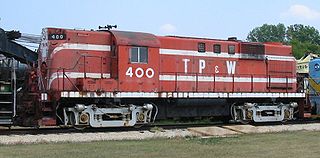
The ALCO RS-11 is a class of diesel-electric locomotive rated at 1,800 hp (1.34 MW), that rode on two-axle trucks, having a B-B wheel arrangement. This model was built by both Alco and Montreal Locomotive Works. Total production was 426 units.

The EMD GL8 was an export diesel-electric locomotive introduced by General Motors Electro-Motive Division (EMD) in 1960. They have been designed as light locomotives with a low axle loading. Measuring 36 feet 2 inches over the end sills, they are equipped an EMD 8-567CR engine producing 875 hp (652 kW) for traction, driving four traction motors in either A1A-A1A or B-B flexicoil trucks. The EMD GA8 is a derivative designed for very light lines with extremely sharp curves using frame mounted traction motors and freight car trucks.
The Rede Ferroviária Federal, Sociedade Anônima was the State-owned national railway company of Brazil created from Brazilian Federal Law #3.115 on March 16, 1957, after several railroads were nationalized by the Brazilian government. However, the railroad did not take full effect until September 30, 1957. The RFFSA linked 42 railways together, creating a regional system composed of 22 railroads. The goal of the RFFSA was to promote and advance the railroad sector of Brazil, creating a north-south-east-west rail network in all five regions of Brazil. But it failed and the RFFSA only served four of the five regions with a north-south rail network win 19 units of the federation of Brazil. By 1999, freight service of the railroad was liquidated and privatized, with the passenger service of the railroad liquidations occurring in 2007.

The G26 is a diesel-electric locomotive built in the US by General Motors Electro-Motive Diesel for export and in Australia by Clyde Engineering under licence. The G26 was developed to increase traction capacities on the tracks which supported lesser axle loadings. They were intended for main line freight and passenger traffic.

GM-Gruppen is a Norwegian heritage railway society that restored and operated Scandinavian diesel locomotives from General Motors Electro-Motive Division (GM-EMD). The organisation has restored one EMD G12, one DSB Class MY, one DSB Class MX and two NSB Di 3.

The EMD G16 is a diesel locomotive built by General Motors in the US and under licence by Clyde Engineering in Australia and MACOSA in Spain. It has been used in Australia, Brazil, Egyptian Railways, Hong Kong, Israel Railways, Mexico, Spain, Yugoslav Railways and on the successor Croatian Railways, Slovenian Railways, Serbian Railways, Macedonian Railways, Republika Srpska Railways, Kosovo Railways and Railways of the Federation of Bosnia and Herzegovina.

T41 was a type of diesel-electric locomotive used by Swedish State Railways between 1956 and 1988 for secondary line services and later for shunting. It was built by Nydquist & Holm (NOHAB), who produced five locomotives under licence from General Motors Electro-Motive Division.
Stadler Rail Valencia SAU is a Spanish company, mainly producing products for the railway industry, subsidiary of Stadler Rail.

The EMD GT26 Locomotive Series made their debut in 1967 after the rise in popularity of the American EMD SD40. Designed to meet most First World, Second World and Third World countries, the GT26 Series were now equipped with a turbocharged high horsepower EMD 645 Series engine as well as six axle HT-C trucks to provide better traction effort at slow speeds. Based on customer input, the GT26 Series would be defined by various designations that suit the customer's railway operations.

The 1400 class was a class of diesel locomotive built by Clyde Engineering, Granville for Queensland Railways between 1955 and 1957.
The 2250 class are a class of diesel locomotives rebuilt by Queensland Rail's Redbank Railway Workshops in 2004.

The NS locomotive series 2900 is a small series of five diesel-electric locomotives that were used by the Dutch Railways between 1970 and 1974. They were taken over by the NS from the State Mines in 1970. In 1975 they were sold to FEVE in Spain. They were built in 1956–1959 by Henschel & Son in Kassel under license from the Electro-Motive Division (EMD).
